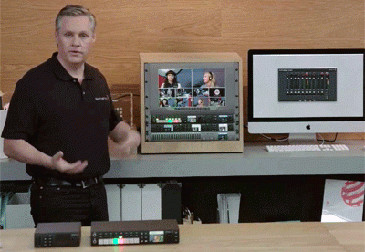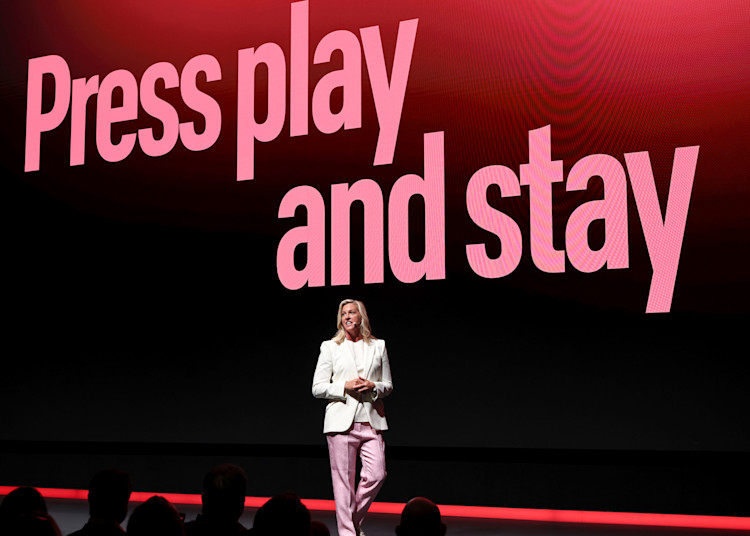Blackmagic Launches New ATEM, Hyperdeck, Streaming Products

Blackmagic CEO Grant Petty
FREEMONT, CALIF.—During a press conference streamed on YouTube Live on Feb. 6, Blackmagic Design CEO Grant Petty announced three new products—a miniature broadcast deck, a live production switcher and a streaming solution—as well as lower-priced, battery-free versions of Blackmagic Studio Cameras.
The first new product, HyperDeck Studio Mini is a miniaturized professional broadcast deck that records and plays back broadcast quality 10-bit video using commonly available SD and UHS-II cards. HyperDeck Studio Mini features 6G-SDI for working with all SD, HD and Ultra HD formats up to 2160p30. Significantly, HyperDeck Studio Mini includes HDMI for monitoring, a built-in sync generator and Ethernet for uploading media via FTP. HyperDeck Studio Mini is available now for $695.
Hyperdeck Studio Mini
With ATEM Television Studio HD, Blackmagic is building on the success of its ATEM Television Studio, which was conceived as a low-cost professional switcher with the ability to grow with the needs of the user. The new miniaturized live production switcher features four 3G-SDI and four HDMI inputs, so customers can connect a total of up to eight different sources such as professional SDI broadcast cameras, consumer HDMI cameras, computers and even video game consoles.
ATEM Television Studio HD is compatible with all SD and HD formats up to 1080p60. There are two channels of analog audio in, RS-422, Ethernet and a built-in IEC power supply, along with program and auxiliary outputs. Customers also get both SDI and HDMI multiview outputs so they can monitor all sources, preview and program outputs, along with labels, audio meters and more, all on a single big screen television or broadcast monitor. ATEM Television Studio HD is available now for $995, the same price as the previous model.
ATEM Television Studio HD
“The original ATEM Television Studio has been a huge hit and is extremely popular with our customers,” said Petty. “The exciting thing about new ATEM Television Studio HD is that it has even more inputs and more features than before, but now makes it possible for customers to create an entire HD program right from the front panel.”
Some of the cost efficiencies in the ATEM Television Studio HD come from the fact that the unit does not offer H.264 streaming. For that, Blackmagic offers the third new product, Blackmagic Web Presenter, which allows customers to use professional SDI and HDMI video sources with streaming software and services such as YouTube Live and Facebook Live.
Featuring 12G-SDI and HDMI connections, Blackmagic Web Presenter downconverts any SD, HD or Ultra HD source to make it look like a 720p USB webcam. Streaming in 720p ensures customers get the quality of HD and a 16:9 aspect ratio, but with very low data rates, so uplinking streams to the internet is easy from even an older computer.
Blackmagic Web Presenter
Blackmagic Web Presenter can also live switch programs using its built-in two-input production switcher when the optional Teranex Mini Smart Panel is installed, making it a full live production solution for location broadcast. Blackmagic Web Presenter is available now for $495, and Teranex Mini Smart Panel is $85.
Finally, Petty described the growing popularity of Blackmagic’s Studio Cameras, which bring professional features like tally and talkback to smaller productions. However, he noted a problem that has cropped up recently. These cameras have big batteries, which adds expense and makes it hard to ship them via air freight. Since Blackmagic Studio Cameras are generally operated while plugged into switchers, his team realized that removing the battery could result in a lower-cost option.
The battery-less Blackmagic Studio Camera HD is $1,495, a $200 savings from the original, while the no-battery Ultra HD Blackmagic Studio Camera 4K has been reduced $800 from $2,495 to $1,695.
A New Era
In making the announcements, Petty said these products are a little bit different from those the company has developed in the past to address the evolving broadcast television and streaming media landscape.
He described the general availability of streaming services such as YouTube Live as marking the beginning of a new era. Web broadcasting, he says, “is the biggest change in the broadcast industry since color television. With a YouTube Live channel, you can actually open up a permanent global broadcast channel, and it goes to all kinds of devices: televisions, computers, tablets. And anyone can do it. So I think that’s a huge thing, and I think it’s going to be a major part of the TV industry. It’s not going to replace broadcast, of course, but it is a major new part.
“What we’re talking about is a new era in web broadcasting,” he continued. “It’s a serious part of the TV industry. And those people who are working in that field don’t want junk products. They want really good quality, high-end broadcast products. But I feel that the feature sets need to be a little bit different. So that’s what you’ll see we’re introducing today. You’ll see very much the products are, they’re great for broadcast and they’re great for AV and areas like that, but you can see we’re really also focused on this new area of web broadcasting.”
This story originally appeared in TVT's sister publication Creative Planet Network.
Get the TV Tech Newsletter
The professional video industry's #1 source for news, trends and product and tech information. Sign up below.
